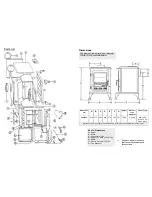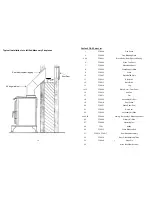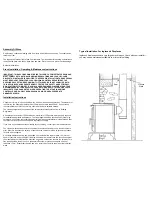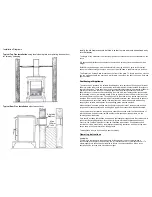
8
PETROLEUM COKE FUELS OR HOUSEHOLD WASTE SHOULD NOT BE BURNT ON THIS
APPLIANCE
Should any difficulties arise over fuel quality or suitability, consult your local supplier or the
Solid Fuel Advisory Service.
Safety Notes For Your Guidance
FIRES CAN BE DANGEROUS –Always use a fire guard to BS6539 specification in the
presence of children, the elderly of the infirm.
Inform all persons the dangers of high temperatures during operation of appliance including the
stove pipe use operating tools provided.
DO NOT OVER FIRE—it is possible to fire the stove beyond its design capacity, this could
damage the stove, so watch for signs of overfiring—if any part of the stove starts to glow red,
the fire is in an overfire situation, and the controls should be adjusted accordingly. Never leave
the stove unattended for long periods without adjusting the controls to a safe setting—careful
air supply control should be exercised at all times.
Warning—Fume Emissions
Properly installed and operated, this appliance will not emit fumes. Occasional fumes from
de-ashing and refuelling may occur. Persistent fume emission must not be tolerated.
If fume emission does persist, then following immediate action should be taken—
1.
Open doors and windows to ventilate the room.
2.
Let the fire out, or eject and safely dispose of fuel from the appliance.
3.
Check for flue chimney blockage, and clean if required.
Do not attempt to relight the fire until the cause has been identified. If necessary, seek
professional advice.
DO NOT FIT AN EXTRACTOR FAN IN THE SAME ROOM AS THIS APPLIANCE
Seasonal Maintenance
If the appliance is not to be used for any length of time, e.g. summer months, then it is
recommended that the appliance is cleaned out thoroughly. Air slides should be lightly oiled
and left partially open to allow circulation of air. Regular monitoring of internals will highlight
condensation problems or water ingress. If these problems occur then the appliance needs
drying and the cause of the problem investigating. It is advisable that after a seasonal
shutdown the appliance is re-cleaned. Remove baffle plate, brick linings, check operation of
grate, check flue for any possible blockages. It is advisable to have the chimney swept at least
once or even twice per year. If the appliance is in constant use, the use of bituminous coal or
poor quality wood makes flues soot and tar up more frequently.
Basic maintenance can be carried out by the appliance operator, i.e removal of baffle plate,
bricks, grate, glass replacement and must be done when the appliance is cold.
Any structural repairs, i.e. panel collar replacement or stove pipe must be carried out by a
suitably qualified engineer.
9
General Maintenance
Baffle Plate
This should be removed at least once a month to prevent any build up of soot or fly ash which
could lead to blocked flueways and dangerous fume emission. If the baffle plate is removed
the chimney/flueway can be swept through the appliance.
Baffle Plate Removal and Replacement
Note position before removal. To remove baffle plate, lift up and remove one side brick left or
right. The baffle plate can now be manipulated out of the stove door opening. Remove the
remaining back and side brick—as the bricks are free-standing no damage can now occur due
to bricks falling over.
To replace, place rear brick in position and one side brick. Manipulate baffle into position and
fit remaining sode brick. Make sure all parts are located.
Grate Removal
The Firefox 5 has a single rotating grate operated by an attached riddling rod. To remove,
unscrew control knob and rotate grate out of its guide hole. The centre grate can now be
removed. To replace grate, reverse this procedure. Note position of grate riddling rod as it
connects to grate. The hook on the end of the rod passes under and up through the arm hole
on the grate. If the removal of the outer grate is required then the baffle plate, rear and side
bricks will require removal. The outer grate will then lift out off it’s stops.
Stove Body
The stove is finished with a heat-resistant paint and this can be cleaned with a soft brush. Do
not clean whilst the stove is hot, wait until it has cooled down. The finish can be renovated
with a suitable brand of paint.
Glass Panels
Clean the glass panels when cool with a proprietary glass cleaner. Highly abrasive
substances should be avoided as these can scratch the glass and make subsequent cleaning
more difficult. Wet logs on heated glass, a badly aimed poker or heavy slamming of the doors
could crack the glass panels. The glass will not fracture from heat.
Chimney
Check your chimney each year before starting to use your stove for the winter. Birds may
have nested in the chimney or the masonry may have cracked. Both chimney and flue pipe
must be swept at least once a year.
To avoid a build up of soot on the baffle (the plate inside the stove above the grate) this must
be removed and cleaned periodically. This plate locates the back and side firebricks so note
its position before removal. To remove, lift plate and remove one side brick, this will allow
plate to drop and aid removal. To replace, position baffle plate on back and side brick, lift plate
and replace remaining brick, make sure it has located in position. This must be done when the
stove is cold.
For efficient burning of your appliance, make sure the grate is clear of burnt debris i.e. nails
etc.








